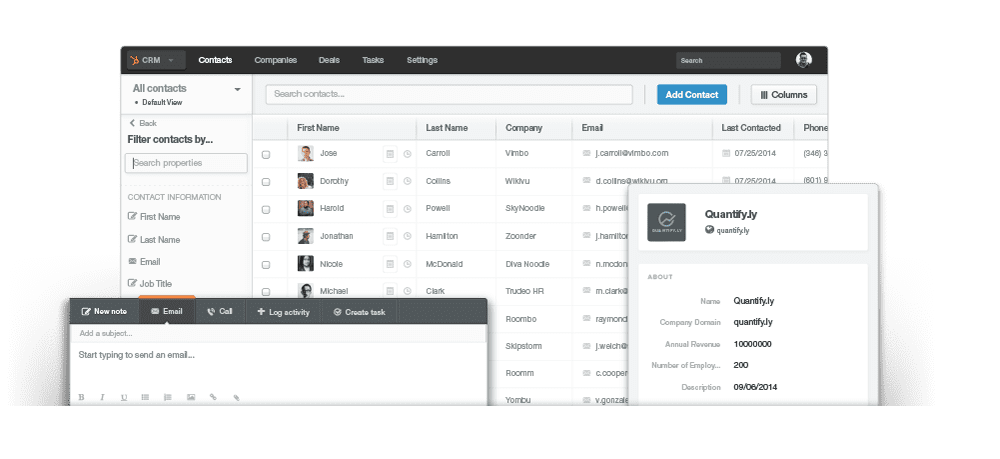
If you’re thinking about breaking into a new industry for the purpose of selling your products or services, there are few things that inbound marketing and social media can offer you to make your efforts more effective.
But with so many different points of entry like Facebook, Twitter, Google+, LinkedIn and blogs—where does one begin?
Inbound marketing is a way to use content to attract your ideal customers to your website. Inbound then uses social media as a distribution mechanism to spread your content to those you hope to do business with by attracting them to your website for lead capture. This methodology has been proven to shorten sales cycles, garner trust with your prospects and boost referrals—which is critical to building a presence in an industry you’ve never been involved with before.
With so many of your prospective customers already on social media, you may be missing out on ample opportunities to fill your sales pipeline.
In this article, we’ll look at how inbound marketing combined with “social media prospecting” can help you break into new industries to prospect new customers.
[box type=”info” size=”large”]Seventy-eight percent of sales people using social media outsell their peers. (Source: Forbes)[/box]
1. Search industry organizations
To begin, start by looking online for trade and industry associations you’re interested in. A simple search should turn up several results. Industry association websites typically have content on industry statistics that you can download for free without paying a membership fee. These pieces of content can give you helpful insight into the industry you’re prospecting. In last week’s article, we highlighted a few of these industries. Trade show websites also provide great sources to learn about the industry you’re investigating. Check out this list of trade associations to get started.
2. Add “top” or “best” to your web search to identify category leaders
It’s funny how most companies will describe their product or services as “top” or being the “best”—even when they are clearly not the best in their category. However, there are some legitimate sources that you can use to your advantage that will point you in the right direction. By simply adding ”best” to your search: best aircraft manufacturer, best hunting brands, top financial advisors, most purchased computer monitors, best doctors in Raleigh, best branding agencies, etc…, you’ll be able to figure out who the leaders are in any given category. This will provide you some framework into the industry you’re looking to do business with and a list of companies to go after.
3. Utilize your personal networks
If you know some people in the industry you are targeting, it doesn’t hurt to call them up and ask them a few questions. Maybe even take them to coffee. Here are some good questions to ask:
- Where do you go for information? Blogs, newspapers, trade journals?
- What are your biggest challenges?
- Where do you acquire most of your customers?
- Who are your customers?
- Do you use social media?
- Do you use Google for search?
- What was the last topic you searched on?
By asking where your potential prospects spend time online (or offline) will help you understand how these people think and where you can focus your marketing and sales efforts in the future.
4. Create relevant content
61% of consumers say they feel better about a company that delivers custom content, and are more likely to buy from that company. (Source: Custom Content Council)
In order for your social prospecting efforts to gain traction, you must create content. Blogs are the first best place to start to attract prospects. Marketers who have prioritized blogging are 13x more likely to enjoy positive ROI. (Source: HubSpot State of Inbound, 2014)
By creating a blog article zeroed in on prospective industry keywords and your ideal customers, you’ll have the ability to share your thoughts, tips and advice with those in the industry you hope to do business with—which creates value. If you have little information to draw upon—start with simple industry statistics. As you become more familiar with the category, more ideas on in-depth topics you can write about will emerge.
 Secondly, create a downloadable offer like an ebook, whitepaper or case study. You can create a landing page on your website specifically targeting the keywords your prospects are using so your page shows up in search results. Using a form will allow you to capture inbound leads once a prospect decides to download your offer. Using inbound tactics saves an average of 13% in overall cost per lead. (Source: HubSpot State of Inbound, 2014)
Secondly, create a downloadable offer like an ebook, whitepaper or case study. You can create a landing page on your website specifically targeting the keywords your prospects are using so your page shows up in search results. Using a form will allow you to capture inbound leads once a prospect decides to download your offer. Using inbound tactics saves an average of 13% in overall cost per lead. (Source: HubSpot State of Inbound, 2014)
When you do reach out over email, social media or phone, your offer has already initiated some initial trust in the mind of your prospect. And with 57% of the purchasing process over before ever talking to sales, its important to make sure your website is up to snuff. (Source: Executive Board)
[box type=”info” size=”large”]You are 70% more likely to get an appointment on an unexpected sale if you join LinkedIn Groups. (Source: Steve Richard, Co-Founder of Vorsight)[/box]5. Social prospecting
The best place to prospect for new customers in a new industry is on social media. LinkedIn, Twitter and Facebook are all great places to start looking for prospects once you know who the players are.
LINKEDIN
The professional network of LinkedIn boasts 225 million members. Top sellers use LinkedIn 6 hours per week. (Source: Jill Konrath)
Seek out industry groups on LinkedIn and join them. Notice what topics are being discussed and join in on the conversation. Share and comment on your potential prospects comments and content. This allows you to establish some thought leadership. Aim to be helpful. Find the names of people and their positions who are the decision makers—more on this below.
TWITTER
Twitter is best for understanding what your prospects are interested in. Use #hashtags to search topics, people and ideas. To find what hashtags your prospects are using, take a look at these top sites to speed the process:
Retweet, favorite and comment on those prospects you are trying to build a relationship with and create a list for those people and companies to organize your feeds.
FACEBOOK
With 1.35 billion users per month, Facebook works the same as Twitter and LinkedIn. Locate the companies you want to work with and “like” them. Comment, share and like the posts to show interest.
It’s important to understand that you must approach social prospecting with the mentality that you want to help—not sell. Any advances that are too “salesy” or aggressive, may put a bad taste in your prospects mouth. Take it slow at first; aim to connect on an emotional level, help and be authentic. The goal here is to warm your leads so that when you do post a blog article or send an email or call them, they’ll know who you are.
[box type=”info” size=”large”]Personal value has 2x as much impact as business value does, and 71% of B2B buyers who see personal value will purchase a product. (CEB)[/box]6. Create a list of prospects using a CRM
Utilize a CRM tool to track your prospects. A great tool we use is Sidekick and HubSpot’s CRM. It allows us to streamline our information gathering and prioritize our leads and sales pipeline more efficiently.
In a typical firm with 100-500 employees, an average of 7 people are involved in most buying decisions. (Source: Gartner Group)
Hubspot’s CRM combined with Sidekick allows you to identify who your potential decision makers are, making your initial calls/contacts more productive.
7. Set SMART goals
No effort should take place without SMART goals (Specific, Measurable, Attainable, Realistic and Timely). A good example of a SMART goal looks something like this:
- Prospect 25 companies that includes the contact information of decision makers
- Identify and connect on LinkedIn, Facebook or Twitter
- Close 2 customers by the end of Q215
- Sales Goal: $50K
Combine SMART goals with your CRM to stay focused and consistent.
To wrap up, breaking into a new industry or vertical can be fun and exciting. Social media prospecting combined with some inbound marketing tactics like blogging, landing pages and content offers can build out your sales pipeline and allow you to make some strong inroads into a lucrative new industry.






